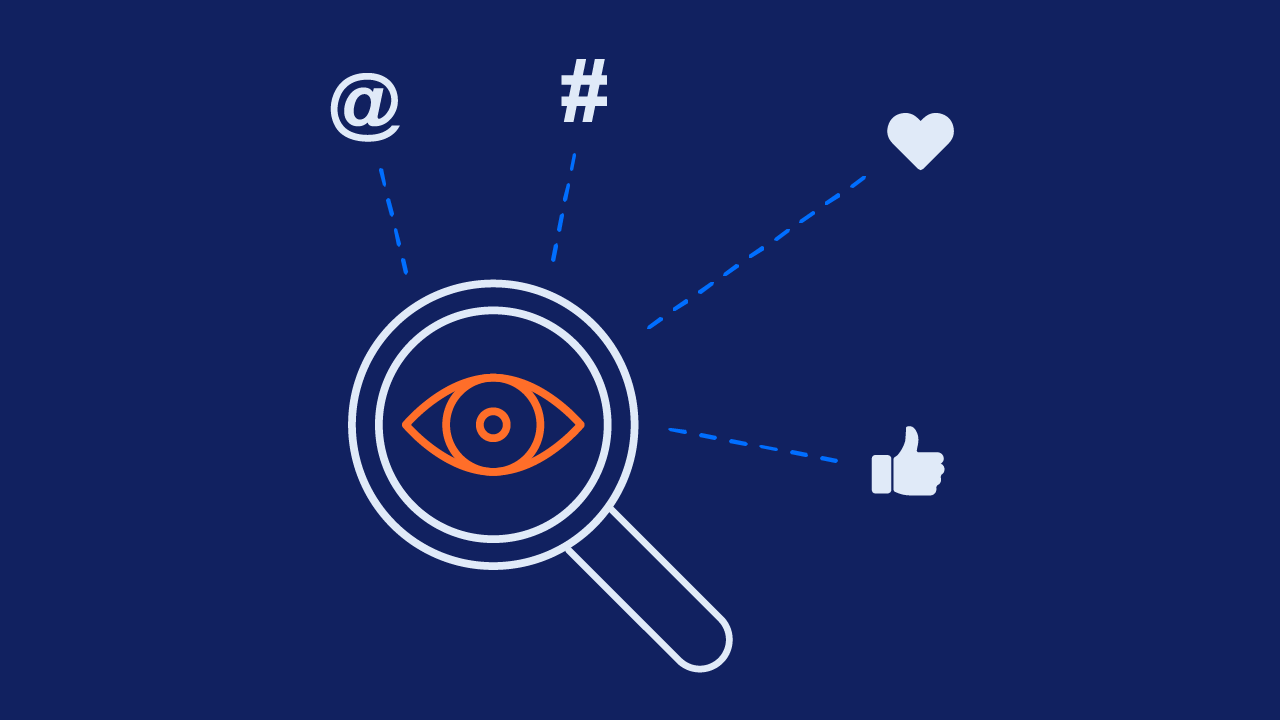Brand monitoring has been a core part of public relations practitioners’ toolkit for years – the only thing that changes is where people talk about your brand.
Print media (newspapers and magazines), TV, and radio were once the biggest platforms for any brand to be mentioned on, but the arrival of the internet and social media changed that. While traditional platforms are still important, digital platforms enable more people to talk (and hear) about your brand than ever before. This kind of exposure can be both an opportunity and a risk.
What Is Brand Monitoring?
Brand monitoring is the act of tracking what people say about your organization, products, and services across different platforms. You do this by looking for conversations or mentions of terms that are important or related to your company and then deciding what response to take.
With so many people potentially talking about you on social media platforms and websites, online brand monitoring is just as important as offline monitoring. You can select keywords related to your company and industry, hashtags, and even profiles of influencers, partners, and people related to the brand.
Monitoring your brand can identify a crisis before it escalates, giving you time to get the perfect response out, as well as engaging with your stakeholders in a way that will leave lasting memories. That can be the difference between success and failure.
How Does This Affect Brand Management?
Improving a brand’s awareness, authority, and value is a part of brand management. There are some strategies and methods that can do this in isolation, but, fundamentally, you can’t make real steps forward without knowing what people are saying about your organization and its offering.
That makes brand monitoring an integral part of brand management. It’s a process that can be used to form strategies and campaigns as well as keep you informed of any developments.
In short, brand monitoring isn’t something you do once and forget about it. It’s an ongoing activity that helps you achieve your goals and addresses any crises.
Brand Monitoring & Management Tactics You Can Use Right Now
We live in an increasingly digital world dominated by media delivered to us through social media platforms on mobile devices. Quite simply, everything we’re supposed to want to see is sent right to our hands.
That opportunity means your brand could be mentioned at any time. Keeping track of every conversation is hard, even with online brand monitoring, but here are some tips to give yourself a better platform to work with and the confidence you’re taking the right steps forward.
Decide What to Monitor and Measure
Data is the foundation needed to reach your goals. If you don’t know your current situation, any decision or action you take isn’t based on anything – and you might not see the results you expect.
The same principle applies to brand management and monitoring. Effective media monitoring helps you find out what people are saying about your brand and products or services so you can make progress toward your goals.
Getting your monitoring, measuring, and reporting set up early means you’ll be collecting data from the start. That’s why you should use brand monitoring software to see who:
- Mentions your brand
- Mentions your products and services
- Uses hashtags you’re associated with
- Uses keywords you’ve selected.
When selecting what to monitor, be sure to take into account misspellings and regional variations of words (especially if you operate globally). That way, you won’t miss out on crucial conversations you want to act on.
Start Building Trust
Building trust is essential to creating meaningful relationships with your audience, turning them into valuable stakeholders.
You can share your message on every platform that exists, but if people don’t trust you to say anything that benefits them, that effort is wasted. It’s an easy trap to fall into: caring so much about what you want to tell people that you miss why they’re giving you their attention in the first place.
The solution is simple. Put in the legwork to understand your audience. Find out what they want from you and curate your messages to meet those expectations – and exceed them where you can.
A one-size-fits all approach might work on a basic level, but it won’t generate the results you’re looking for. Spend time helping your stakeholders and build trust with them so they know who to turn to when they need your products or solutions.
Respond in a Timely Manner
In a perfect world, each piece of coverage and every conversation about your brand would be positive. That may be one of the goals for every brand management activity, but how you bring about this positive coverage can be tricky – especially when there may be factors you can’t control.
A good product and great service go a long way toward generating positive conversations and publicity, but this standard is what consumers consider normal. When something doesn’t live up to this expectation, that’s when conversations that can have a negative impact start to appear.
This less-than-ideal publicity isn’t always something you can influence or prevent, but you can be aware of it with online brand monitoring.
Once you find this coverage or these mentions, you have the chance to get involved. It might be replying to something positive or addressing the concerns raised in a more negative post – sentiment analysis can help here – but whatever it is, act quickly to show that you’re engaged with your audience – just like you’d like them to be with you.
Take Control of the Narrative
When conversations start, or your brand is featured in media coverage, it could be about anything:
- A new product launch
- A positive review
- A new campaign
- A negative experience
- A partnership
- Something a done or said by a brand representative.
Positive coverage is easier to handle and act on, but still requires a guide as to what to do. When a situation emerges from negative conversations or features, a crisis communication plan can make all the difference.
Given how quickly negative conversations and coverage can spread, your efforts shouldn’t be focused on that single interaction or platform. Responding is crucial, but that message needs to be consistent across a range of platforms to make your position clear.
Consistency isn’t enough on its own, though. The key here is to reinforce your message often, adapting as events change. Not only is your aim to keep the brand in focus while saying the right things, but you can slowly start to own the narrative and move it from being reactive to proactive.
You’ll reach a larger audience by overcommunicating across your channels, so more people can see what you’re doing to resolve whatever has happened. This means working with teams across the organization to ensure you remain consistent while working toward your goals.
Brand Monitoring Software Makes Your Job Easier
You can spend hours each day going through each platform to find mentions of your brand, your products, and keywords you’re tracking, which isn’t the best use of your time. Brand monitoring software, such as CisionOne, can help you find all of these conversations in one place, making it easier to get a full picture of what’s happening with your brand.
Think of what you can do with all of the time you spend on manual monitoring brand or product mentions back in your calendar. That’s an opportunity for more campaigns, letting you focus on delivering results that really make a difference to the business.
Find out how CisionOne can make brand monitoring easier by scheduling a demo with one of our experts.








